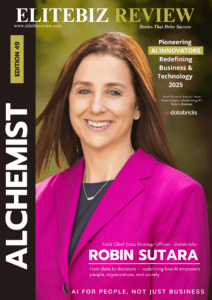In today’s rapidly evolving digital era, the story of artificial intelligence is not only about algorithms, data pipelines, or computational breakthroughs. It is also about the visionaries who bridge technology with humanity, translating innovation into meaningful outcomes for people, organizations, and society. Robin Sutara, Field Chief Data Strategy Officer at Databricks, is a true representation of innovation, with a career that began in maintaining Apache helicopters in the U.S. Army to advising global enterprises on data and AI strategy highlights how technology, when guided by purpose-driven leadership, can be truly transformative.
Her story is both unconventional and deeply inspiring—a reminder that innovation is not confined to linear career paths but often shaped by curiosity, resilience, and the desire to solve real-world challenges. With more than two decades of experience across Microsoft and Databricks, Sutara has emerged as one of the most influential voices in advancing responsible AI, democratizing data, and helping enterprises translate cutting-edge technology into measurable impact.
A Non-Traditional Journey with a Purpose
Robin Sutara never followed the typical path into data and technology. Her foundation was laid in the U.S. Army, where she worked on repairing the weapons and electrical systems of Apache helicopters. In that high-pressure environment, she discovered a love for problem-solving and the precision of technology. Yet what truly set the course for her career was a deeper realization: data had the power not only to transform organizations, but also to improve the lives of the people within them.
Over more than two decades at Microsoft, Sutara’s journey reflected this belief. From her early days in consumer support to overseeing Azure Data Engineering Operations, she advanced to become Microsoft UK’s Chief Data Officer. Through each role, she witnessed the same truth—technology alone is not the endgame. The real impact comes when people are empowered to harness data, turning information into insight and insight into better decisions.
Her move to Databricks in 2022 represented both a natural progression and a bold new chapter. Having experienced firsthand the frustrations of fragmented data ecosystems, Sutara was drawn to Databricks’ mission of unifying structured and unstructured data with AI into a single governed platform. Today, she collaborates with hundreds of global customers, helping them not only implement technology but also transform their cultures into data-driven organizations.
As she explains, “Technology alone is never enough. True transformation happens when organizations embrace cultural change—when people are empowered to solve problems, innovate, and make decisions informed by trusted data.”
How AI Is Reshaping Data Strategy in 2025
In her role as Field Chief Data Strategy Officer, Sutara sees firsthand how AI is fundamentally altering enterprise data strategies. The shift, she notes, is not incremental but transformative.
She outlines three major changes defining 2025:
- Democratization through natural language.
Tools like AI/BI and Genie allow business users to query data in plain English, opening insights to employees far beyond data science teams. This democratization ensures decision-making is no longer the privilege of a select few but an organizational capability.
- The rise of the Data Intelligence Platform.
Unlike traditional platforms, Databricks’ intelligent Data Intelligence Platform understands the semantics of an organization’s data, enabling automatic optimization, intelligent infrastructure management, and natural language interfaces.
- The critical importance of unified data foundations.
As AI adoption accelerates, the cost of data silos becomes clearer. Fragmentation undermines security, governance, and AI effectiveness. Databricks addresses this by combining lakehouse architecture with generative AI, creating a platform capable of optimizing performance and managing infrastructure within the context of specific business goals.
For Sutara, this evolution reflects more than a technical milestone. It is a shift toward future-oriented innovation, where AI does not merely report on the past but predicts, prevents, and empowers organizations to act proactively.
Translating AI into Tangible Business Value
Her leadership is marked by an exceptional ability to bridge innovative thinking with tangible business outcomes. She emphasizes that deploying sophisticated models is not enough—organizations must align people, processes, and technology with clear objectives.
She points to a powerful example from the manufacturing sector, an industry generating more than 1,800 petabytes of data annually. A leading client suffered significant financial setbacks, running into millions, because of unforeseen downtime. By unifying IoT sensor data, ERP maintenance records, environmental information, and technician notes within Databricks’ platform, they could implement predictive maintenance models.
The results were transformative:
- 67% reduction in unplanned downtime within one year
- Over $12 million in cost savings
- 23% improvement in product quality
- A cultural shift as teams moved from reactive firefighting to strategic planning
Perhaps most importantly, the initiative built trust in AI recommendations. Maintenance teams, production managers, and data scientists collaborated in new ways, empowered by a shared, data-centric mindset.
As Sutara reflects, “The success came not just from the technology, but from changing how people worked together, trusted insights, and embraced a culture of data-driven decision-making.”
Principles for Responsible and Ethical AI
As AI becomes more embedded in daily life, concerns about fairness, transparency, and inclusivity grow louder. To Sutara, responsible AI isn’t a choice but a necessity for fostering trust and driving lasting innovation.
Her approach rests on six guiding principles:
- Fairness and Inclusiveness: AI must reduce bias, not amplify it. This requires diverse teams that challenge assumptions and question data sources.
- Reliability and Safety: Systems must be consistent with human values and monitored continuously to prevent harm.
- Transparency and Clarity: Individuals impacted by AI should have a clear understanding of how decisions are reached.
- Accountability: Responsibility for outcomes must be well-defined, ensuring both organizational and societal accountability.
- Privacy and Security: Robust governance, encryption, and risk management are non-negotiable.
- Human Oversight: AI must augment rather than replace human judgment, with diverse voices guiding design and deployment.
At Databricks, these principles are operationalized through frameworks like the AI Security Framework, which identifies 62 technical risks and provides pathways for balancing innovation with safety.
Sutara insists that building trustworthy AI requires continuous vigilance: “Responsible AI is not a compliance checkbox—it is a commitment that must guide decisions across the entire lifecycle.”
Leadership Lessons from AI Transformation
Over decades of guiding data and AI adoption across industries, Sutara has learned that transformation is more about people and culture than technology.
Her key lessons include:
- Start with the “why.” Employees must understand how AI solves specific problems and makes their work more meaningful.
- Create psychological safety. Innovation requires safe experimentation where failure is seen as learning.
- Invest in upskilling. Organizations cannot simply hire AI talent—they must empower existing employees through comprehensive skilling programs.
- Embed governance early. Treating governance as an afterthought slows progress and introduces risks.
To balance innovation and risk, she applies an Innovation-Risk Alignment Framework, defining clear risk appetites, deploying AI gradually, incorporating feedback loops, and ensuring human oversight. This structured yet adaptive approach builds confidence and prevents costly missteps.
Advancing Women in Data, AI, and Technology
As a female leader in a field still dominated by men, Sutara is committed to supporting women pursuing careers in data and AI. She offers direction that is as useful in practice as it is rooted in personal experience.
She encourages women to embrace non-traditional backgrounds as strengths, build intentional networks of mentors and sponsors, and develop both technical literacy and business acumen. She stresses the importance of speaking up, taking up space, and supporting others once success is achieved.
Her own journey—from the Army to the C-suite—has shown her that diversity is not only about fairness but about better outcomes: “Diverse teams build better products, make fewer biased decisions, and deliver stronger business results.”
As chair of North America for Women in Data Global, she ensures that others have the support she often lacked early in her career. Her advocacy reflects a larger belief that AI innovation must be inclusive to be truly effective.
What Sets Databricks Apart
Today, Databricks stands out for seamlessly integrating data management, analytics, and artificial intelligence. According to Sutara, its differentiation lies in several areas:
- Rooted in invention: Born from the creators of Apache Spark, Delta Lake, MLflow, and Unity Catalog, Databricks embodies a culture of innovation.
- Smart Platform: The Data Intelligence Platform understands the meaning behind data, allowing it to self-optimize and provide access through natural language.
- Centralized governance: With Unity Catalog, organizations gain a single layer of oversight across data formats, cloud environments, and processing engines—delivering security and compliance from the very start.
- Open, multi-cloud architecture: Databricks integrates with leading platforms and tools across AWS, Azure, GCP, and beyond, offering flexibility without lock-in.
- Continuous innovation: Ongoing reinvestment in R&D keeps the platform future-ready, with new features such as Agent Bricks, LakeBase, and enhanced AI/BI announced at the recent Data + AI Summit.
These capabilities, Sutara notes, enable enterprises to move from data to insight to action faster, with governance and trust built into the foundation.
Industries Poised for AI Transformation
Looking ahead, Sutara predicts five industries will experience the most profound AI-driven transformation in the next three to five years:
- Manufacturing: Predictive maintenance, machine vision, and supply chain optimization are redefining efficiency and quality.
- Healthcare: From diagnostics to drug discovery, AI is enabling personalized, preventative care while navigating complex privacy requirements.
- Financial Services: AI is revolutionizing risk management, compliance, and customer personalization.
- Retail and E-commerce: True “segment-of-one” personalization is creating entirely new consumer experiences.
- Energy and Utilities: AI is optimizing smart grids, renewable integration, and predictive infrastructure maintenance to support sustainability goals.
She emphasizes that the winners will be those who scale beyond pilots into production-ready AI systems supported by unified data foundations and robust governance.
The Human Motivation Behind Data and AI
For all her technical expertise, Sutara’s passion for data and AI is rooted in human potential. She is motivated not by algorithms themselves, but by the breakthroughs they enable—whether preventing disease, reducing environmental impact, or empowering employees to make better decisions.
She stays inspired by connecting with customers, committing to continuous learning, mentoring, and focusing on practical AI applications that improve daily life. For her, true change is built through persistence; it’s less about sprinting ahead and more about navigating the inevitable obstacles with resilience.
“Every breakthrough opens new possibilities,” she reflects. “We are still in the early days of what’s possible, and I want to help build the foundations for the next generation of innovators.”
A Vision for 2025 and Beyond
If Sutara could define her vision for how AI will reshape business and society, it would center on three transformative shifts:
- Democratization of expertise. By 2025 and beyond, AI will make specialized knowledge universally accessible, enabling decision-making at every level of organizations and across communities.
- Shift from reactive to predictive and preventative. From healthcare to urban planning, organizations will anticipate and prevent problems before they arise.
- Augmentation of human capabilities. AI will not replace people but expand what they can achieve, unlocking new frontiers in science, engineering, and the arts.
This vision rests on foundations of responsible AI, equitable access, continuous reskilling, and robust governance. It envisions a world where work becomes more meaningful, decision-making more distributed, and innovation more inclusive.
Conclusion: Building the Foundations of the Future
Robin Sutara’s journey and leadership at Databricks exemplify what it means to be a pioneering AI innovator in 2025. Her career reflects resilience, her philosophy emphasizes responsibility, and her vision champions inclusivity and empowerment.
Through her work, she demonstrates that AI is not merely about technology—it is about enabling people and organizations to solve problems, unlock potential, and address the greatest challenges of our time.
As AI continues to redefine business and society, leaders like Sutara are ensuring that transformation is guided by trust, ethics, and a commitment to amplifying human capability.
The future she envisions is one where AI serves humanity’s highest aspirations, and where organizations equipped with unified platforms, responsible governance, and inclusive cultures will not only thrive but help build a better, more resilient world.

